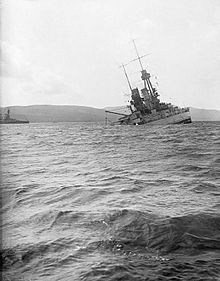Sydney Fremantle
Sir Sydney Robert Fremantle | |
|---|---|
| Born | 16 November 1867 |
| Died | 29 April 1958 (aged 90) |
| Allegiance | United Kingdom |
| Service/ | Commander of the Légion d'honneur (France) (Italy)Commander of the Order of the Redeemer (Greece) Commander of the Order of the Rising Sun (Japan) Commander of the Order of Saints Maurice and Lazarus |
Family
Sydney was born into a naval family on 1 January 1867, the eldest son of Admiral Sir Edmund Robert Fremantle and his wife Barberina Rogers Isaacs.[1][2]
Prewar service
Fremantle followed his father into the navy, joining up in 1881.
Fremantle joined the
First World War
Fremantle became second-in-command of the
He was
Postwar
Scapa Flow and the scuttling of the fleet

Fremantle continued in the navy, becoming commander of the
Fremantle had destroyers tow sinking ships ashore and beach them, while boarding parties attempted to reverse the scuttling or order the Germans aboard to do so. Those Germans who abandoned ship were picked up. Reuter was brought aboard Fremantle's flagship, HMS Revenge, where he and Fremantle engaged in a brief argument with the aid of an interpreter.[13] The following day, Fremantle assembled Reuter and his officers on the deck of Revenge, and through an interpreter informed them of their breaches 'of faith and honour' and accused them of recommencing hostilities by sinking their ships.[14] The prisoners were then led into captivity.[14]
Later life
Fremantle received a promotion to full admiral in 1922, and in 1923 was appointed Commander-in-Chief, Portsmouth, a post he held until 1926.[2][6] He retired from the Navy in 1928, having been appointed a Knight Grand Cross of the Order of the Bath, and a Member of the Royal Victorian Order.[15]
He eventually wrote his memoirs, entitled My Naval Career: 1880-1928, and published them in 1949.[2][6]
He married Lelia Hope Fremantle on 1 December 1896, and on 1 August 1931, he married for the second time, this time to Geraldine Margaret Cooke-Collis.[16] He had three children by his first wife, one of whom, Edmund Seymour Denis Fremantle, also served in the Navy, receiving the Distinguished Service Order for service in the Second World War and twice being mentioned in despatches.[17]
Admiral Sydney Fremantle died on 29 April 1958 at the age of 90.[1] He donated most of his papers, which are held in the collections of the National Maritime Museum, and King's College London.[2][6]
References
- ^ a b c Mosley (ed.). Burke's Peerage, Baronetage & Knightage, 107th edition. p. 918.
- ^ a b c d e f g h i j k l "Fremantle, Sir Sydney Robert, Admiral, 1867-1958". Retrieved 25 June 2009.
- ^ Humble. Fraser of North Cape. p. 23.
- ^ Kent. Signal!. p. 67.
- ^ Kent. Signal!. p. 68.
- ^ a b c d e f "FREMANTLE, Sir Sydney (Robert) (1867–1958), Admiral". Retrieved 25 June 2009.
- ^ Halpern. A Naval History of World War I. p. 68.
- ^ a b Rose. Power at sea. p. 5.
- ^ a b c van der Vat. The Grand Scuttle. p. 162.
- ^ van der Vat. The Grand Scuttle. p. 163.
- ^ van der Vat. The Grand Scuttle. p. 169.
- ^ van der Vat. The Grand Scuttle. p. 175.
- ^ van der Vat. The Grand Scuttle. p. 179.
- ^ a b van der Vat. The Grand Scuttle. p. 180.
- ^ Mosley (ed.). Burke's Peerage, Baronetage & Knightage, 107th edition. p. 917.
- ^ Mosley (ed.). Burke's Peerage, Baronetage & Knightage, 107th edition. pp. 917–8.
- ^ Mosley (ed.). Burke's Peerage, Baronetage & Knightage, 107th edition. p. 919.
Bibliography
- "Fremantle, Sir Sydney Robert, Admiral, 1867-1958". Archive Catalogue. The National Maritime Museum. 2008. Retrieved 25 June 2009.
- "FREMANTLE, Sir Sydney (Robert) (1867–1958), Admiral". Archive Catalogue. King's College London, Liddell Hart Centre for Military Archives. Retrieved 25 June 2009.
- Halpern, Paul G. (1995). A naval history of World War I. Routledge. ISBN 1-85728-498-4.
- Humble, Richard (1983). Fraser of North Cape: the life of admiral of the fleet, Lord Fraser, 1888-1981. Routledge. ISBN 0-7100-9555-4.
- Kent, Barrie H. (2004). Signal!: A History of Signalling in the Royal Navy. Permanent Publications. ISBN 1-85623-025-2.
- Charles Mosley, ed. (2003). Burke's Peerage, Baronetage & Knightage, 107th edition. Vol. 1. Wilmington, Delaware: Burke's Peerage (Genealogical Books) Ltd.
- Rose, Lisle Abbott (2007). Power at Sea. University of Missouri Press. ISBN 978-0-8262-1702-8.
- ISBN 978-1-84341-038-6.
External links
- The Dreadnought Project: Sydney Fremantle
 Works by or about Sydney Fremantle at Wikisource
Works by or about Sydney Fremantle at Wikisource
